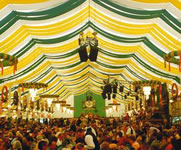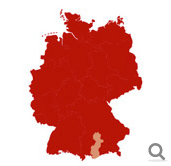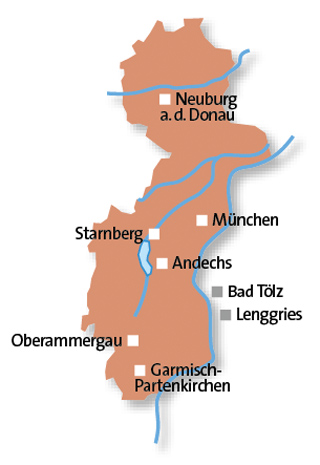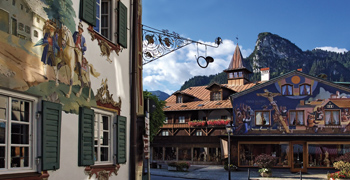
Historical Towns
- Historical towns in Brandenburg
- Cathedral Towns and Cities in Saxony-Anhalt
- The innovative Anhalt-Wittenberg Region
- Enchanting towns in the Harz
- The beautiful towns and cities in Saxony
- Towns and cities of culture in Thuringia
- Beautiful towns of Franconia
- East Bavarian traditional towns
- Alpine towns in the Allg�u
- The eastern Akpine Foothills and their towns
- Towns and villages in the western foothills of the Alps
- Mediterranean towns on Lake Constance
- Towns in the Swabian Alb
- Unspoilt towns in the Black Forest
- Towns for refined tastes in the Heilbronner Land
- Towns in the Odenwald
- Wine towns in Rheinhessen
- Saarland, a region of contrasts
- Romantic towns in the Hunsr�ck and Nahe Regions
- Idyllic towns and villages in the Moselle Region
- The Ahr Rhine Eifel holiday region
- Wine towns on the Romantic Rhine
- Modern towns and cities in the Bergisches Land Region
- The Lahn Valley and its fairytale towns
- Historical towns in Kurhessisches Bergland
- Sauerland's scenic towns
- Fairytale towns in the Weserbergland Hills
- Majestic towns in the M�nsterland Region
- The nine stars of Lower Saxony
- North and East Frisian Islands
- Vibrant Schleswig-Holstein
- Maritime towns along Mecklenburg's Baltic Coast
- Historical Hanseatic Towns
- Germany's Baltic Sea Islands
- The Mecklenburg Lakes
Contact and information
Picture-book locations set against spectacular mountain scenery, where traditions are very much alive

Oberammergau
Many traditional houses in Upper Bavaria are decorated with exquisite Lüftl art, but nowhere is this quite as magnificent as in Oberammergau. These illusionistic facade paintings are more prevalent in this region than anywhere else. The cultural highlight for visitors is undoubtedly the impressive Oberammergau Passion Play Theatre with its capacity for five thousand spectators. Every ten years the local community stages the famous Passion Plays portraying the suffering, death and resurrection of Christ, a tradition which has its origins in a vow made by the people of Oberammergau during the Thirty Years' War. The play, next performed in 2010, has long attracted visitors from all corners of the globe. Oberammergau also has a long tradition of wood carving spanning 500 years.Zugspitze
Located on the German-Austrian border is the spectacular Zugspitze, Germany's highest peak at 2,962 metres. It is a winter sports paradise: about 350 metres below the summit, the Zugspitzplatt plateau provides ideal conditions for skiing and snowboarding and is Germany's only glacial ski area. The Bayerische Zugspitzbahn (cog railway) takes you up to the plateau. There is an extensive network of walking trails around the Zugspitze. The routes are well-marked and take you through some breathtaking gorges such as the Höllental (hell valley).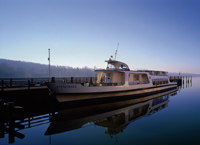
Lake Ammersee
After Altötting, Andechs is Bavaria's most important pilgrimage town, with its Benedictine abbey set in idyllic scenery beside Lake Ammersee. The abbey is famous for the products of its brewery and kitchen, with Andechs branded bread rolls and cheese also made under licence. The former castle was originally the ancestral seat of the Counts of Andechs. A few years ago, the abbey and its rococo church celebrated their 550th anniversary on the `Holy Mountain', an event that many took as an opportunity to visit Lake Ammersee and see the newly restored pilgrimage church. An insider's tip for a relaxing break: spend a few days with the Benedictine monks. You can also watch wood carvers at work at Pilatus House in Oberammergau, or pay a visit to one of the local sights, such as Ettal Abbey, or the romantic Linderhof Palace and the fairytale castle of Neuschwanstein, both built for King Ludwig II of Bavaria.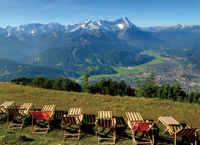
Garmisch-Partenkirchen
After the 1936 Winter Olympics, there was no going back for Garmisch and Partenkirchen. The two market towns were merged for the games and have been associated with winter sports in Bavaria ever since. The original Olympic Ice Stadium is now a venue for both sporting and cultural events. Ludwigstrasse in the heart of Partenkirchen dates back more than two thousand years. With its cosy inns and little shops it is the perfect place to browse or shop. A trip to the area would not be complete without a visit to Partnachklamm gorge. An iron bridge over the river at a height of 68 metres provides an exciting vantage point from which to watch as the raging water surges through the narrow ravine.Neuburg an der Donau
Neuburg Palace on the Danube houses a collection of 120 masterpieces of Flemish baroque painting including works by Peter Paul Rubens, Jan Brueghel the Elder and Anthony van Dyck. This offshoot of the Bavarian State Art Collection in Munich's Alte Pinakothek opened in 2005.Traditional beer brewing
The art of brewing has been practised in the western foothills of the Alps since the 12th century. Every year in the summer and autumn, you can sample the great variety on offer in beer gardens and at beer festivals, which are popular with locals and visitors alike. The Munich Oktoberfest is Germany's best known and largest public festival. Here you can enjoy a huge glass of beer fresh from the barrel, roast chicken and pretzels accompanied by traditional brass band music. And for dessert, there are Tölzer Prügel, sumptuous chocolate fingers which get their name from the logs which are used for building rafts.Travel Planner
Select an option...
Romance and charm
The town of Landsberg am Lech, situated on the Romantic Road, hosts the Ruethenfest festival. It is one of the largest traditional children's festivals in Bavaria and dates back more than 100 years. It will next take place in 2011.
Food and drink
Asparagus from Schrobenhausen this Bavarian speciality has been widely cultivated here since 1913. There are now 600 or so asparagus farmers, who grow this `royal' vegetable in the sandy soil around Schrobenhausen from Aichach to Hallertau.
History and tradition
The Blue Rider group of artists was based in Munich, Murnau and the area around Kochel. After the `Bridge' painters, they represent the second highly influential movement of Expressionist art in Germany.
Nature and scenery
The Schleierfälle (Veil Falls) in the Ammergau Alps are so called because the water looks like a fairy's veil as it flows over the moss-covered stones. A woodland walk takes you to this mystical place.




